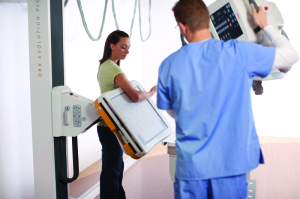by
Lauren Dubinsky, Senior Reporter | November 17, 2016

Carestream's DRX-Evolution
Plus imaging system
From the November 2016 issue of HealthCare Business News magazine
Digital radiography (DR) technology offers better images with lower dose and a much more efficient workflow, but is it worth the investment? With reimbursement cuts on the horizon for film and computer radiography (CR), the answer may be yes. Because of the speed that DR systems offer, facilities can schedule more patients in a given day. The images are available for review in a matter of seconds because the technologist doesn’t have to acquire them from a CR reader or develop film.
Like CR, DR systems can be integrated with the facility’s RIS and PACS, so the images can be sent directly to the radiologist after they are acquired. The DR images are higher quality than film and CR images. But like many high-end technologies, the cost is a major stumbling block. Upgrading existing equipment to DR systems from major manufacturers like Carestream, Fujifilm, GE Healthcare, Konica Minolta, Canon, Agfa HealthCare and Shimadzu can range from $66,000 to $130,000, according to ECRI’s new report, “With Reimbursement Cuts Looming, Should I Upgrade to Digital Radiography?” Manufacturers have been providing ways to transition to DR at a more affordable cost.
Looming reimbursement cuts
In mid-December 2015, the Consolidated Appropriations Act of 2016 was passed by Congress and signed into law by President Barack Obama. Section 502 states that reimbursement for X-ray exams that are conducted with film or CR will be cut in the coming years. “People have been lobbying for an increase in reimbursement for DR because of the added costs, but what they got instead was keeping the reimbursement the same for DR and cutting everybody else,” says Jason Launders, director of operations of the health devices group at ECRI.
The policy changes are only applicable for analog and CR exams that are reimbursed through the Medicare Physician Fee Schedule and Hospital Outpatient Prospective Payment System. Medicare reimbursement will be cut by 20 percent in 2017 for exams performed with analog equipment, and 7 percent in 2018 and 10 percent in 2023 for exams done with CR equipment. The facilities that are expected to be affected by this legislation are certain outpatient facilities and freestanding imaging centers that submit Current Procedural Terminology (CPT) codes like 71010 (Radiologic examination, chest, single view, frontal) and 71020 (Radiologic examination, chest 2 views, frontal and lateral).
Some manufacturers are reaching out to their customers to help them transition to DR before the cuts go into effect. Agfa’s Fast Forward to DR program offers its DR Retrofit to facilities with either film or CR equipment, and Konica Minolta has created an educational program to assist orthopedic, podiatry, urgent care and other practices. Smaller clinics such as an orthopedic surgeon’s office don’t mind using CR because they use it for follow-up exams instead of diagnostic purposes, says Lisa Williams, clinical analyst at MD Buyline.

David Shipp
lower radiation HMMM
November 18, 2016 11:20
If by lower doses you mean there is less chance that repeats will be made, then yes, in that case you can claim lower dose. Any one who has installed and set up a CR system knows that you will need a higher technique than with film, to get quality images. The rest of your statements are true.
to rate and post a comment